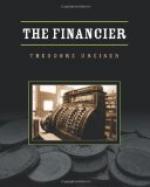The growth of young Frank Algernon Cowperwood was through years of what might be called a comfortable and happy family existence. Buttonwood Street, where he spent the first ten years of his life, was a lovely place for a boy to live. It contained mostly small two and three-story red brick houses, with small white marble steps leading up to the front door, and thin, white marble trimmings outlining the front door and windows. There were trees in the street—plenty of them. The road pavement was of big, round cobblestones, made bright and clean by the rains; and the sidewalks were of red brick, and always damp and cool. In the rear was a yard, with trees and grass and sometimes flowers, for the lots were almost always one hundred feet deep, and the house-fronts, crowding close to the pavement in front, left a comfortable space in the rear.
The Cowperwoods, father and mother, were not so lean and narrow that they could not enter into the natural tendency to be happy and joyous with their children; and so this family, which increased at the rate of a child every two or three years after Frank’s birth until there were four children, was quite an interesting affair when he was ten and they were ready to move into the New Market Street home. Henry Worthington Cowperwood’s connections were increased as his position grew more responsible, and gradually he was becoming quite a personage. He already knew a number of the more prosperous merchants who dealt with his bank, and because as a clerk his duties necessitated his calling at other banking-houses, he had come to be familiar with and favorably known in the Bank of the United States, the Drexels, the Edwards, and others. The brokers knew him as representing a very sound organization, and while he was not considered brilliant mentally, he was known as a most reliable and trustworthy individual.
In this progress of his father young Cowperwood definitely shared. He was quite often allowed to come to the bank on Saturdays, when he would watch with great interest the deft exchange of bills at the brokerage end of the business. He wanted to know where all the types of money came from, why discounts were demanded and received, what the men did with all the money they received. His father, pleased at his interest, was glad to explain so that even at this early age—from ten to fifteen—the boy gained a wide knowledge of the condition of the country financially—what a State bank was and what a national one; what brokers did; what stocks were, and why they fluctuated in value. He began to see clearly what was meant by money as a medium of exchange, and how all values were calculated according to one primary value, that of gold. He was a financier by instinct, and all the knowledge that pertained to that great art was as natural to him as the emotions and subtleties of life are to a poet. This medium of exchange, gold, interested him intensely. When his father explained to him how it was mined, he dreamed that he owned a gold mine and waked to wish that he did. He was likewise curious about stocks and bonds and he learned that some stocks and bonds were not worth the paper they were written on, and that others were worth much more than their face value indicated.




